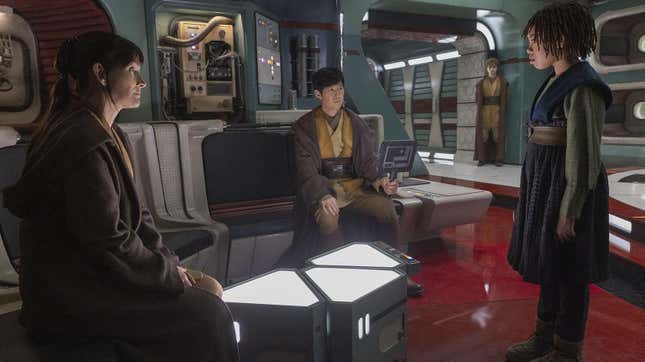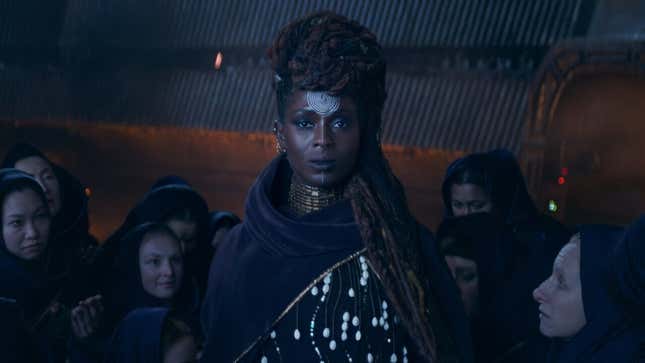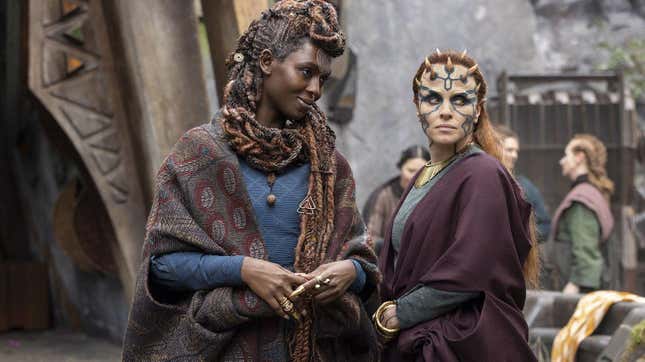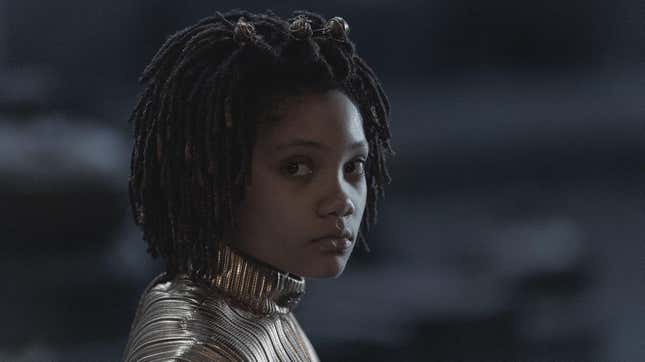
The Acolyte Just Blew Star Wars Wide Open, From a Certain Point of View
Star Wars is filled with half-truths. Even as its fans crave the reliability of a rigorously defined canon, the saga has always played in the realm of mythologizing itself, and twisting what we’ve been told in new lights. After all, this is the story where Obi-Wan once defended himself to Luke as not a liar, but a teller of the truth, from a certain point of view. Star Wars lies, it adds context, it changes, it offers interpretation—its story grows, from one view into many. The Acolyte is no different.
It’s fitting then that the new series, fascinated as it is with vision and with institutional edict, dives deep into this idea with its own spin on the Rashomon effect, in a stunning episode that—while offering up this layer of obfuscated, unreliable interpretation to certain elements underpinning its overarching mystery—also asks us to consider that maybe not everything we have previously understood about the Force, about the Jedi and their dogma, or the spiritual side of Star Wars at large, is ever quite what we thought it might be.

“Destiny” jukes where one might expect The Acolyte to jive, pulling us away from the immediate narrative thrust of the premiere last week—that assassin Mae is on her way to off the Wookiee Jedi Kelnacca, after her twin Osha and the Jedi she’s now working with failed to apprehend her—for an episode that is entirely set in flashbacks. Taking us back 16 years to the planet Brendok, where Mae and Osha were born, the episode begins to peel back the layers of the relationship between these two sisters (their younger selves played here by sisters Leah and Lauren Brady, respectively), and the tragic circumstances that not only tore them apart, but set them on mirrored paths beyond the life they knew: Osha’s road toward the Jedi, and Mae’s into the arms of the Dark Side.

But if last week’s dual-episode premiere didn’t offer you enough indications that what our heroes know of what happened on Brendok was already not the entire truth, “Destiny” from the get-go places itself in the lens of an unreliable narrator. The episode has a perspective that is clear throughout: that the version of events that we see play out here is Osha’s view of what happened the day her family died—the day the Jedi Order saved her from a terrible tragedy and the selfish hurt of a twin sister. Is it what happened? Well, perhaps, from a certain point of view. “Destiny” makes the bold choice to never explicitly frame its recollection through an older Osha or Mae recounting these events, but asks its audience to both trust what it’s given—and also, as Sol intoned to his youngling trainees last week, to rely on more on than what is literally shown to them.
Throughout “Destiny” it is Osha that we follow most keenly, are asked to most empathize with in her plight. We see it in her yearning to be more than what her mothers, Aniseya (Jodie Turner-Smith, in a best-in-show performance) and Koril (Margarita Levieva)—leaders of a coven of Force users unlike anything we’ve seen on Star Wars so far, and much more on that later—want her to be, as part of an “ascension” ritual that will make both her and her much more willing sister Mae the destined successors to the coven’s power. We see it in Osha and Mae’s sibling bickering, quite different from what we were briefly told of their past intimacy, a constant back and forth of barbs and little fights. We see it when the Jedi appear at the coven’s doorstep uninvited—an arrival shot with an almost villainous presence, as they come on word of hearing there are potentially Force-sensitive children in their midst—and Osha is allowed to briefly connect with a younger master Sol, and the promise of a life beyond what she knows on Brendok. And when things do break badly—Osha refuses to lie on her mother’s instruction when the Jedi test her and Mae’s sensitivity, leading to a fight between the sisters that sees Mae cruelly trap her in their room and burn Osha’s diary—the escalation of events that leads to the final tragedy is once again all from Osha’s point of view.

Mae’s anger at her sister leaving almost sharpishly becomes violent, an escalation that goes from another of their little squabbles to her attempting to murder the sister she, up to this point, has been desperate to keep by her side. And what starts as a small fire—a burning book—suddenly becomes an inferno that hasn’t just engulfed Osha’s room, but the entire coven, blowing apart buildings and reactors, sending rubble flying everywhere and bridges tumbling down into the depths below (and seemingly Mae with it, after Sol manages to rescue Osha from a similar fate—but we all know how that one played out now, don’t we?). It’s also very suddenly deposited multiple piles of dead witch bodies, Aniseya included, all over the town, as Sol flees the terror with Osha in hand, the young girl now sent to be a Jedi out of tragic necessity rather than the willingness Osha displayed earlier. It’s certainly a point of view of what happened on Brendok. But it feels wrong. Nothing quite adds up, things never get laid out quite cleanly, things feel sudden and abrupt, and like they hit you out of nowhere: but intentionally so, rather than through a narrative misjudgement.
That inkling across the premiere episodes that Sol, Indara, Kelnacca, and Torbin know something bad happened on Brendok becomes a roiling fire of its own this week: even as we’re told one thing by our unreliable perspective, there is enough here to point the audiences screaming in the direction of asking more questions. What the hell happened here that saw the coven go from hiding children, to reluctantly but willingly allowing Osha to leave, to them being wiped out? How did one small fire become an explosive inferno? Why did Mae react so violently to losing the sister she loved? What are these Jedi hiding?

Whatever The Acolyte has left to tell us of the events on Brendok remains to be seen—in a series of twinned protagonists and perspectives, it wouldn’t be all too surprising to revisit this tale as the show progresses, and get someone else’s perspective, be it Sol’s, or Mae’s, or someone else’s, on these events. But even as “Destiny” so masterfully weaves this history into Mae and Osha, from a slanted perspective, running throughout it is another tale of perspective with much, much larger ramifications for Star Wars beyond their twinned tale. It’s one of the very nature of the Force itself, of Jedi theology in practice, and a question raised at the Star Wars prequels and beyond that asks us, just as the main narrative in Osha and Mae’s backstory does, to question everything we know.
Simmering in the background of Osha’s interior conflict about wanting a life beyond what her mothers and their coven have asked of her in “Destiny” is the nature of what has been asked of her in the first place. As we’re introduced to the coven’s belief system, we learn that they interpret the Force in a very different way to how it’s been presented to us through years of Jedi perspective. It’s more than just the fact that Aniseya calls it “the Thread” rather than “the Force;” there’s a power to it, yes, and a will, but it’s also something someone powerful enough in their understanding of it can directly manipulate—that the Thread can be pulled, as Aniseya tells Osha in their final conversation, as she lets her daughter go to be a Jedi. To Aniseya and this coven of witches, fate is ultimately decided by the individual, not some cosmic will. They are explicitly the same mystical energy—we see Aniseya teach Osha and Mae to try and push and pull it like we’ve seen Jedi do time and time again—but it’s this idea of the living nature of this energy where the coven and the Jedi Order differentiate. It’s where sparks begin to fly with the realization that the Jedi have an outpost on Brendok perhaps specifically because there are people on that world teaching a philosophy about the Force that is not their doctrine, and why Indara’s insistence that they have a right to test any potential children they find suddenly becomes more like a threat than merely a differing point of view.

That itself becomes very interesting when Aniseya and Koril casually acknowledge what is, to the audience, a bombshell: that Osha and Mae were a product of immaculate conception, born to their mothers from the Thread itself. Perhaps not unlike a dyad, a shared connection and power split across two focal beings in the Force. Perhaps not unlike a certain Jedi-prophecized Chosen One that will come to pass a hundred years down the line. Everything we as the audience have been told up to this point in Star Wars canon is that this kind of creation of life has been through the lens of the Jedi and Sith dichotomy. That the Sith have tried to experiment with, to corrupt and manipulate nature itself, to extend their own lives at the extent and cost of others. That to the Jedi, such a manifestation is crux of a prophecy to bring balance (and they believe, destroy their fated enemies in the Sith for good, no matter what we go on to learn in the Skywalker saga), and a reflection of the Force’s living nature and will.
But the coven instead offers a perspective that breaks the chains of this one specific interpretation of what the Force is, and what it is capable of: one that, as Aniseya tells her followers building up to the ascension ritual that will make Osha and Mae the coven’s next great witches, some would see as dark or unnatural. That others, like them, would see as a miracle. But even within that framework, Osha and Mae are not beholden to a specific destiny. They are not chosen ones, they are still free to make their own choices, whatever the consequences—and they can pull the Thread themselves, because they are as part of it as it is part of them. And of Osha and Mae don’t have to be chosen miracles, these singular inflection points of the Force, did Anakin have to be one? Was he the Chosen One because that’s just what the Jedi—the Order that we see in this episode bristle when confronted with the idea that there dare be other spiritualists teaching children their ways rather than those of the Order—said he was? Was Rey and Ben Solo’s connection born of the interpretations of Light and Dark they were shaped by, or was it something else entirely, something that freed them both from what it means to be Jedi, or to be Sith, at all?

We’re not given answers here, just as we are not given all the answers about what really happened on Brendok. We could, down the line, learn more that changes all this—that broadens The Acolyte’s perspective of the Force even further, or pulls it back closer to that previously understood dichotomy. After all, as “Destiny” reminds us over and over again, what is laid out here is but one perspective, one interpretation, of the way things are. But in setting up its greater mystery, that The Acolyte also asks us to consider these fundamental ideas about Star Wars—and offer the chance for us ourselves to pull the Thread, to be freed of an interpretation driven by Light and Dark, by Jedi and Sith, and find a new perspective in between and beyond—sets the stage for a series that goes beyond just a compelling, personal story of the stakes between these two sisters, and into something that broadens and enhances Star Wars’ wider sense spirituality in ways we’ve never quite seen on-screen so far.
Regardless of how this specific story plays out, that we have that chance is liberating and fascinating, in and of itself.
Want more io9 news? Check out when to expect the latest Marvel, Star Wars, and Star Trek releases, what’s next for the DC Universe on film and TV, and everything you need to know about the future of Doctor Who.
